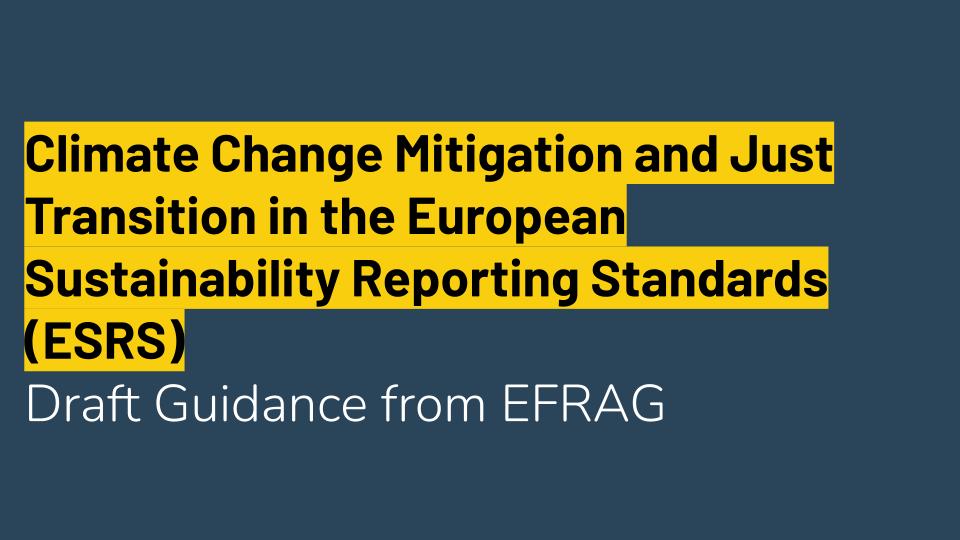The European Financial Reporting Advisory Group (EFRAG) has released its fourth draft guidance (IG 4) on how companies should disclose their climate strategies to comply with EU regulations. EFRAG previously issued its first three ESRS Implementation Guidance documents, covering materiality assessment (IG 1), value chain (IG 2), and ESRS data points (IG 3). The latest guidance (IG4) clarifies requirements under the European Sustainability Reporting Standards (ESRS) and outlines expectations for corporate climate transition plans, incorporating just transition. More specifically, this guidance is designed to assist preparers and users of ESRS sustainability statements in implementing disclosure requirements related to transition plans for climate change mitigation (Disclosure Requirement(DR) ESRS E1-1 and relevant ESRS 2 relevant Disclosure Requirements).

Background
The ESRS includes two Cross-Cutting Standards: general requirements (ESRS 1) and general disclosures (ESRS 2).
- ESRS 1 establishes key concepts and principles that must be adhered to when reporting under the Corporate Sustainability Reporting Directive (CSRD)
- ESRS 2 provides reporting requirements applicable under the topical standards. These requirements are mandatory for all companies, irrespective of their sector.
The ESRS provides guidance on DRs (Disclosure Requirements) and ARs (Application Requirements). The AR16 (Application Requirements) of ESRS 2 provides an overview of the sustainability topics, sub-topics and sub-sub-topics (collectively ‘ sustainability matters ’) covered by topical standards.
The sustainability matters covered by topical ESRS are classified into three categories – Environmental, Social and Governance. There are five standards for environmental (E1-E5), four standards for Social (S1-S4) and one for Governance (G1). The first environmental topic is Climate Change(E1), and within that, there are 3 subtopics (Mitigation, Adaptation and Energy). The EFRAG guidance that is discussed in this article is applicable to the sub-topic of Climate Change Mitigation within the E1 standard.
The EFRAG guidance document details how transition plans should be integrated within the ESRS framework. Transition plans are gaining importance across EU legislation, including the Corporate Sustainability Reporting Directive (CSRD), EU Taxonomy, Corporate Sustainability Due Diligence Directive (CSDDD), EU Green Bonds and EU Emissions Trading Scheme (EU–ETS), among others.
Disclosure on material negative impacts arising from a Transition plan
Further details of the guidance are given in the subsequent sections, but one of the areas that we were really impressed with was the focus on a “just transition”. It is a known fact that there are monetary costs, social costs and environmental costs to the decarbonization and shift to a net-zero economy. If the social cost is not addressed, there will be no political support for implementing the agenda towards a cleaner future.
The EFRAG Guidance paper acknowledges the negative impacts of a transition plan, and requires the preparer to disclose three types of negative consequences
- Just Transition – whether people are affected as a result of the transition plan
- Biodiversity – whether the transition plan is creating positive or negative IROs( Impacts, Risks and Opportunities)
- Adaptation – whether the mitigation measures are having a negative impact on the adaptation measures.
We believe that this is an impact step by EFRAG is helping companies articulate not only the positive impacts of their transition plans, but also to weigh in on their negative impacts.
Got questions about ESG or sustainability?
Book a free and nonbinding discovery call to discuss your questions with one of our sustainability experts, and learn how we can help you.
Other highlights
Draft IG 4 highlights the following key points:
- EU Paris Aligned Benchmarks (EU- PAB) : Undertakings must disclose their climate targets, detailing how these align with the Paris Agreement’s 1.5°C objective. Read more about PABs and CTBs at our blog here.
- Decarbonization Measures: Undertakings should describe the decarbonization strategies, such as operational and product adjustments, that contribute to emissions reductions.
- Investment and Funding: Required disclosures include investments and funding for climate transition initiatives, such as EU Taxonomy-aligned capital expenditures (CapEx).
- Supporting Disclosures: For activities within the EU Taxonomy, undertakings must disclose alignment with Taxonomy criteria, covering climate goals and compliance with technical screening requirements. (Read more on EU Taxonomy here, here and here).
Conclusion
Draft IG 4 provides a comprehensive framework to ensure that undertakings align their climate strategies with the Paris Agreement, supported by clear governance, funding, and progress reporting requirements. By embedding climate goals into core business strategies, this guidance aims to enhance transparency and accountability in companies’ transition to a sustainable, low-carbon economy.
Download the document here.
About NordESG
NordESG is an advisory firm helping corporates develop, articulate and execute their ESG and sustainability strategies. Our work includes sustainability performance reporting support under various ESG frameworks, strategy development or conducting materiality assessments. By doing so, we help businesses meet their disclosure compliance requirements like CSRD but also help them proactively communicate their strategy to other stakeholders like investors, customers and local communities in which they operate. Our work is focused mainly on Europe and North America.
Discovery Call
Book a free discovery call below
Get in touch via email
Disclaimer
This communication is marketing material. The views and opinions contained herein are those of the author(s) on this page, and may not necessarily represent the views expressed or reflected in other NordESG communications or strategies.
This material is intended to be for information purposes only. It is not intended to provide and should not be relied on for accounting, legal or tax advice, or investment recommendations. Reliance should not be placed on the views and information in this document when taking individual investment and/or strategic decisions. Information herein is believed to be reliable, but NordESG does not warrant its completeness or accuracy.
Some information quoted was obtained from external sources NordESG consider to be reliable. No responsibility can be accepted for errors of fact obtained from third parties, and data and information contained in this communication may change in the future. The views and opinions expressed in this communication may change.